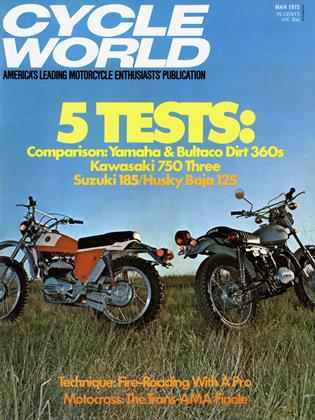REPORT FROM ITALY
CARLO PERELLI
GIUSEPPE GILERA
The last of the great Italian pioneers is gone. On the opening day of the Milan show, Giuseppe Gilera died at 84 of cancer in his Arcore Villa. He is survived by his wife Ida and two daughters.
Genial and determined, he began developing his factory in 1909, ending up with the second largest bike plant in Italy. His enthusiasm for the sport was deservedly rewarded by numerous laurels.
Fifty years before Soichiro Honda, Güera was a supporter of the fourstroke engine. He studied strokers, but never built one, in spite of their immensely increased performance value in recent years.
Güera started working when he was only 15, and served as apprentice in three of the most famous bike factories in those times: Bianchi, Moto-Reve and Bucher & Zeda. Shortly afterward, he set up a micro-workshop of his own and built his first four-stroke. This was a 3 17-cc Single with pushrod-actuated overhead valves. It topped 65 mph at a time when the side-valve or automatic inlet-valved competition was considerably slower.
As soon as he could, he began competing with his own bikes. Güera earned his first victory in the classic Cremona event with an average speed of 66 mph. The year was 1912, and it was also the first victory for an all-Italian-built machine.
He was also very successful in hillclimb competition prior to WWI. Technique in those days was unusual out of necessity, as the primitive engines used to stall in tight turns. Güera, like most riders of that time, pushed their mounts through turns like these, only remounting at the beginning of the straights.
Shortly before the war’s outbreak, Güera migrated to Arcore, not far from Monza, and began producing some really reliable bikes. In fact, his mounts won the ISDT Trophy in both 1930 and ’31—the only times Italian machinery has earned this honor.
Wishing to have a go at grand prix racing in 1936, Güera bought the rights for a highly promising 500 named the Swallow, developed by a team of Tome engineers, including the now famous Piero Taruffi, which was quite futuristic for the time. It was a supercharged Four with water cooling and a claimed output of 80 bhp at an incredible 8800 rpm. Unfortunately, it had very little road holding ability, which required a lot of patience to cure. By 1939, though, problems were solved, and Dorino Sera fini rode the bike to the European championship.
(Continued on page 98)
Continued from page 96
Still, it was after the war that the Gilera Four really achieved fame. And, it did so sans blower (which new FIM rules banned), and without water cool ing. In all, 10 world championships were taken with this design. The last came in 1957 when the Arcore factory withdrew from GP racing along with Moto Guzzi and Mondial.
Gilera's first real shock in life came in 1956, shortly before his pull-out from racing. In that year, his only son Ferruccio died in Argentina. After that, Gilera fortunes seemed to decline. The depression of the national market and some unlucky occurrences in foreign markets sent the once glorious factory into debt. Finally, in 1969, Gilera was forced to sell to the Piaggio concernafter trying to save the situation by selling everything he had. His only consideration was that the Gilera name would go on.
PREMIO VARRONE
Italy also has a "Bike of the Year" contest. Ours is called Premio Varrone and is attracting more and more atten tion because the decisions are handed down by a completely independent jury made up of excellent riders.
This year, only superbikes made it to the final. These are as follows: BMW R75/5, Honda CB750, Moto Guzzi V7 Sport, Kawasaki Mach III, Laverda SF750, Triumph Trident, and Ducati's GT750.
After a close fight, the outright winner is the Moto Guzzi V7 Sport. It's a fine machine too, with stamina, speed, and tremendous road holding abilities. About all that keeps it from being perfect is a slight deficiency in the braking department.
To give you an idea of the scope of this evaluation, a list of the various categories judged and the machines winfling in each are as follows: technical design, Honda; braking, Honda/Ducati; road holding, Moto Guzzi; handling, Moto Guzzi; dimensions and weight, Kawasaki; top speed, Moto Guzzi; cruis ing speed, Moto Guzzi; acceleration, Kawasaki; pulling power, Ducati; main tenance, BMW; mechanical noise, Hon da; vibrations, Honda; fuel consump tion; Honda; instruments, Honda; aes thetic line, Moto Guzzi.
 View Full Issue
View Full Issue














